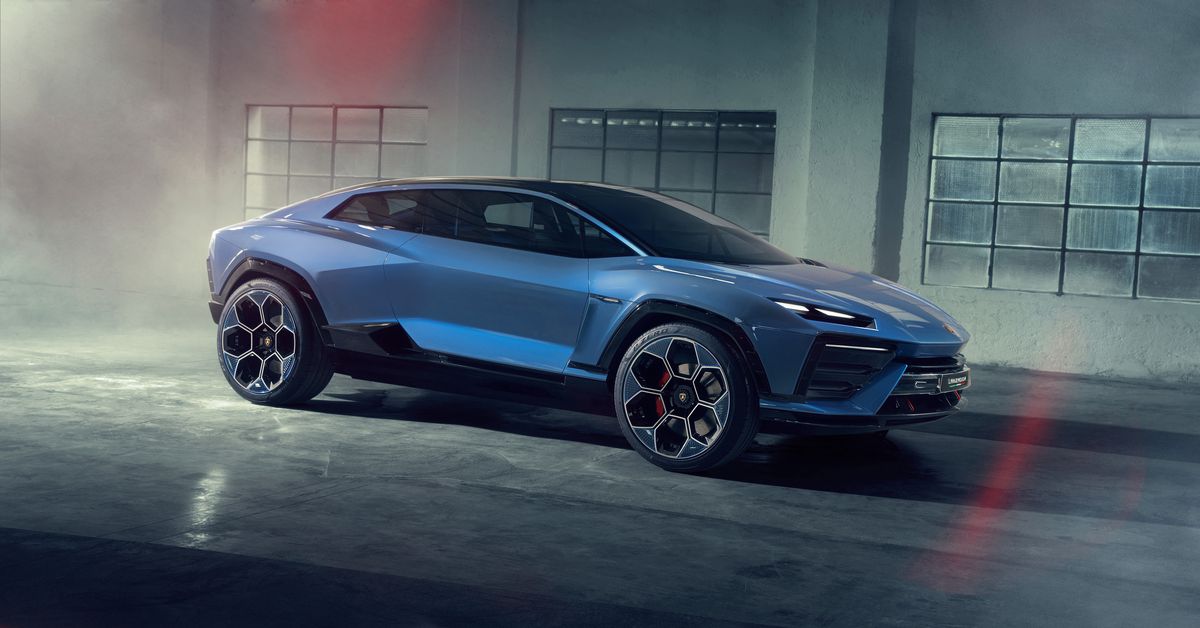/cdn.vox-cdn.com/uploads/chorus_asset/file/24858284/Lamborghini_Lanzador_Concept__1_.jpg)
Lamborghini’s plans to introduce a new, pure battery-electric fourth model to its lineup came into sharper focus today with the reveal of the Lanzador concept at Monterey Car Week. A high ground-clearance grand tourer with 2+2 seats and large 23-inch wheels, the Lanzador blends styling elements from the Urus and Sián while settling into a shape that is all its own.
It isn’t Lamborghini’s first all-electric concept — that honor goes to the Terzo Millennio concept from 2017 — but it is the most serious sign of the storied Italian automaker’s efforts to pivot to battery-powered performance.
a:hover]:text-gray-63 [&>a:hover]:shadow-underline-black dark:[&>a:hover]:text-gray-bd dark:[&>a:hover]:shadow-underline-gray [&>a]:shadow-underline-gray-63 dark:[&>a]:text-gray-bd dark:[&>a]:shadow-underline-gray”>Image: Lamborghini
Of course, as soon as I cracked open the Lanzador’s press release, I immediately searched for all those EV-related specs that would prove this concept would be one of the most powerful EVs on the road. But Lamborghini is being coy about details like range, battery, charging capacity, or even zero to 60mph acceleration. The Italian sports car maker did reveal one tantalizing bit of information: the Lanzador is capable of “peak power of over one megawatt.”
Lamborghini is being coy about details
That’s the equivalent of 1,341 mechanical horsepower, which would place the Lanzador somewhere between a Lucid Air Sapphire (920kW) and a Tesla Roadster (1,100kW). And while that doesn’t tell us much about energy delivery per hour, it does offer a hint about performance, which we can likely assume is, well, fast. Can the Lanzador sprint from zero to 60mph in under two seconds like some of its peers in the 1,000hp-plus community? Lamborghini wouldn’t say.
Driving the Lanzador promises to be an experience unlike any other. “Significantly” more sensors and actuators will be integrated into the supercar’s dynamic driving control to ensure the smoothest ride possible. The Lanzador’s algorithmic computer takes in data to deliver a nuanced driving experience that improves over time.
a:hover]:text-gray-63 [&>a:hover]:shadow-underline-black dark:[&>a:hover]:text-gray-bd dark:[&>a:hover]:shadow-underline-gray [&>a]:shadow-underline-gray-63 dark:[&>a]:text-gray-bd dark:[&>a]:shadow-underline-gray”>Image: Lamborghini
“This allows the driving character to be more precisely differentiated to the individual driver than ever before: information delivered back to the driver by intelligent sensors positioned behind the new ‘pilot’s’ glass panels mounted at the front of the car, giving a taste of future radar technology,” Lamborghini says.
The Lanzador’s algorithmic computer takes in data to deliver a nuanced driving experience
Of course, the Lanzador was designed to optimize aerodynamics for improved driving and range. Air resistance can be adjusted to respond to a driver’s unique preference. It’s a similar system to what was put to use in the Huracán Performante and Aventador SVJ, along with “new active aero devices in the front and rear to ensure the best efficiency” whether in Urban or Performance driving modes. And an active chassis with a steerable rear axle and air suspension are able to be controlled through the steering wheel.
The hexagonal-shaped taillights with three LED elements on each side take their inspiration from the Countach LPI 800-4. And speaking of the hexagon, the beefy 23-inch wheels combine hexagonal elements with aeroblades to minimize turbulence.
a:hover]:text-gray-63 [&>a:hover]:shadow-underline-black dark:[&>a:hover]:text-gray-bd dark:[&>a:hover]:shadow-underline-gray [&>a]:shadow-underline-gray-63 dark:[&>a]:text-gray-bd dark:[&>a]:shadow-underline-gray”>Image: Lamborghini
Those wheels give the Lanzador a much higher ground clearance than typically found in Lamborghini’s lineup, with the closest antecedent being the Urus SUV. The roof height is 1.5 meters, or a little less than five feet, so it’s still shorter than the much taller Urus. But those wheels will give the Lanzador the appearance of being able to climb over all manner of road obstacles — or at least up the rolling hills of Northern Italy.
Putting performance aside, you can see Lamborghini is enamored with the Lanzador’s combination of a GT body shape with a high-riding driving style. The aim was to mimic the Huracán Sterrato, an off-roader supercar that the automaker only committed to a limited run of 900 units.
a:hover]:text-gray-63 [&>a:hover]:shadow-underline-black dark:[&>a:hover]:text-gray-bd dark:[&>a:hover]:shadow-underline-gray [&>a]:shadow-underline-gray-63 dark:[&>a]:text-gray-bd dark:[&>a]:shadow-underline-gray”>Image: Lamborghini
a:hover]:text-gray-63 [&>a:hover]:shadow-underline-black dark:[&>a:hover]:text-gray-bd dark:[&>a:hover]:shadow-underline-gray [&>a]:shadow-underline-gray-63 dark:[&>a]:text-gray-bd dark:[&>a]:shadow-underline-gray”>Image: Lamborghini
Lamborghini said the Lanzador’s design was inspired by spaceships, with the driver meant to feel like an astronaut or jet pilot while driving. The driver and passenger — or “pilot and co-pilot,” as Lamborghini puts it — sit in a frame-like bucket seat insulated with 3D-printed foam. The rear seats can be folded down to accommodate luggage. And there’s even a front truck that can fit a specially made bag.
In addition to 3D-printed materials, Lamborghini is also committing itself to a more sustainable supply chain with the inclusion of recycled nylon and plastics as well as regenerated carbon fiber for some of the interior. The automaker claims its leather and wool procurement is sustainable and produced using renewable energy. And it uses a type of synthetic yarn made from recycled plastics.
a:hover]:text-gray-63 [&>a:hover]:shadow-underline-black dark:[&>a:hover]:text-gray-bd dark:[&>a:hover]:shadow-underline-gray [&>a]:shadow-underline-gray-63 dark:[&>a]:text-gray-bd dark:[&>a]:shadow-underline-gray”>Image: Lamborghini
a:hover]:text-gray-63 [&>a:hover]:shadow-underline-black dark:[&>a:hover]:text-gray-bd dark:[&>a:hover]:shadow-underline-gray [&>a]:shadow-underline-gray-63 dark:[&>a]:text-gray-bd dark:[&>a]:shadow-underline-gray”>Image: Lamborghini
Unlike previous EV concepts, the Lanzador is a preview of what’s to come. Lamborghini is two years into a €1.9 billion ($2 billion) electrification strategy in which it will first roll out gas-electric hybrid versions of its entire lineup before introducing, in 2028, a brand-new all-electric fourth model. We’ve already seen one plug-in hybrid, the 2024 Revuelto, which will ultimately replace the Aventador. And there will certainly be more to come.
The Lanzador is meant to conjure up what’s possible with that model. And since it’s just a concept, it’s too early to get bogged down in performance figures or battery specs. Though it’s telling that Lamborghini put one spec out into the world — 1MW of peak power — a signal to all of its competitors that whatever’s coming, it will be ridiculously powerful.
Services Marketplace – Listings, Bookings & Reviews
